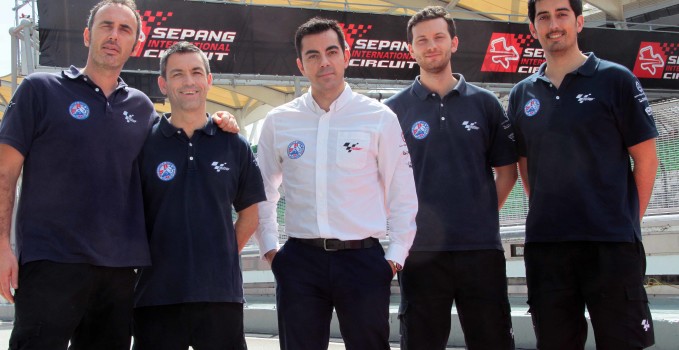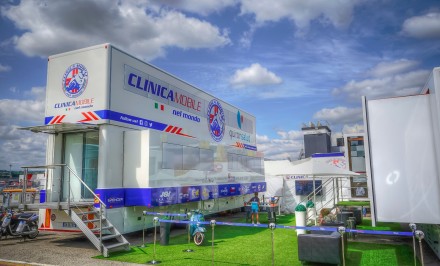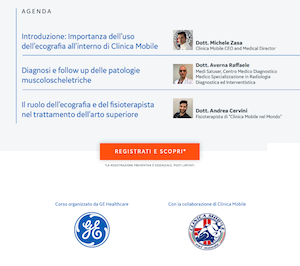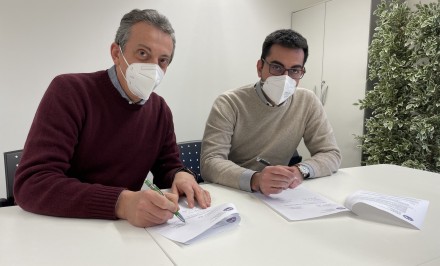InsideLineMedia – A Q&A With Clinica Mobile’s Doctor Michele Zasa – Insight into the world of Clinica Mobile.
Rider safety is the most important aspect of any Grand Prix weekend. And as racing evolves, as does the technology that keeps a rider safe during a crash.
But that doesn’t mean that they are invincible, and when a rider does hurt themselves their first stop is to the Clinica Mobile.
The Clinica Mobile is the travelling medical facility that looks after the well being of everyone in the paddock. Founded in 1977 by Doctor Claudio Costa, the Clinica has been instrumental in saving the careers’ and lives’ of many riders since, thanks to their rapid on-site assistance.
The Clinica Mobile is now in its fifth generation and is headed by Doctor Michele Zasa. With the 2016 season just around the corner, Dr. Zasa kindly spoke to Inside Line Media about the day-to-day operation of the Clinica, its future plans and his proudest moments working in Grand Prix racing.
Inside Line Media: The Clinica Mobile is an integral part of Grand Prix racing and is currently in its fifth generation. How does this modern version compare to the early days of the Clinica?
Dr. Michele Zasa: “Many aspects have changed over the years, starting from the role of the Clinica Mobile, which was the only source of medical care until the introduction of medical centres at all racetracks in the 1980’s. Nowadays, injured riders are first taken to the medical centre where the first emergency phase is done; afterwards they are transferred to hospital if the injury is severe. A doctor from the Clinica Mobile always accompanies the rider, also to the hospital. This is essential to facilitate communication between riders and foreign doctors. For simple fractures or trauma in general, riders can be attended directly by the Clinica Mobile.
“Structure and facilities have significantly changed and improved. The truck we use now is much larger and fully equipped with everything we need to perform an excellent medical service. Major changes have been introduced in terms of technology and innovation: two years ago we bought a very good X-ray machine which detects small fractures that in the past you couldn’t see. Also, in the physical-therapy field, we are using several devices like lasers, diathermy and magnetotherapy. Work and data management is improved by a platform we created with a partner last year, to keep record of medical interventions and collect data about the riders. With this solution we can do statistics at the end of the season and analyse how we can improve and plan our services. With the 2016 season, a mobile app will be integrated within this platform so that riders will be able to book in advance their treatment.”
ILM: What was it that drew you to motorsport and in particular bike racing?
Dr. Zasa: “Ayrton Senna was one of my favourite sportsmen, and I wanted somehow to honour his memory with my job. I had the chance to work at the Imola circuit, the very same track where Senna died. There I met Dr. Costa, who founded Clinica Mobile at Imola 40 years ago.
He needed a new, young and motivated doctor, able to deal with the kind of trauma and injuries that are common among riders, and who could also speak a few languages. I wanted to travel around the world, so when he asked me to join his team I accepted his offer without hesitation.”
ILM: What was it like working under the guidance of Doctor Claudio Costa?
Dr. Zasa: “I really enjoyed my experience with Dr. Costa, I am very grateful for the opportunity he gave me. I have so many good memories of those times, and not only for the medical expertise acquired on the field with him as an excellent mentor. The greater lesson I learnt is the importance of understanding the emotions of the riders, which is not an easy task. Under his guidance I became truly passionate about my job, and I am now happy to be 24-hour available for the riders.”
ILM: The Clinica looks after the entire paddock each race weekend, so what goes into running an operation like that?
Dr. Zasa: “From a logistics perspective, there is a lot to move around from race to race: the unit, medical equipment and supplies, all the high-tech devices that we need in our daily work at the track… and no to forget staff members! During European races, three doctors, a radiologist and six physiotherapists are tending to patients. Up to eight patients can be treated at the same time.
“Just to give you an idea, here are some numbers regarding the 2015 season: 1442 hours worked during 18 races, 2966 medical interventions, 7699 physiotherapy treatments. Work is really increasing race by race, that is why planning, organisation and team work are really fundamental.”
ILM: What is a typical Grand Prix weekend like for the Clinica?
Dr. Zasa: “Since most of the riders arrive at the track on Wednesday, part of the staff is already available from that day, and from Thursday until Sunday afternoon all my crew is working at full speed. Weekend days are definitely the busiest ones, not only for injuries that might occur on track, but also for physiotherapy needs. Many riders come daily for a sport massage or a specific therapy to recover from previous injuries, or simply to improve their performance and relax after riding or working out.
“Normally riders receive treatment at our unit, but some of them like Valentino Rossi, prefer to avoid the paddock crowd and have a massage at their motorhome. Everybody can show up at the Clinica Mobile, it’s a service for the entire paddock and even a commentator with sore throat or a mechanic with back pain can easily have access to treatment.”
ILM: Safety in motorsport is constantly evolving. In your opinion, is MotoGP doing enough to ensure the safety of its competitors? Is there anything you would like to see change?
Dr. Zasa: “Safety is our main priority, and a lot has been done so far to improve this aspect and reduce injuries. Protective equipment has definitely increased safety with the airbag and the kind of skins used. Helmets are also made with top-quality materials to improve safety and comfort. Also, safety requirements are constantly reviewed and modified if necessary by IRTA and Dorna, and track maintenance is performed on a regular basis which helps avoiding crashes due to bad conditions of tracks.”
ILM: You must deal with injuries of all kind, but is there a particular one that you deal with almost every race weekend? Does it change as bikes evolve and become faster?
Dr. Zasa: “Statistics on injuries might change in the long term, considering the safety improvements discussed above, and other major changes in the history of this sport. For example, a significant change was done from the two-stroke to the four-stroke engine, the first one being difficult to control and getting high-side easily. New riding styles with riders getting closer to the ground, or new extreme electronic features might also cause safety issues. Anyway, in general, the areas that are most exposed to trauma are hand, wrist, shoulder, collarbone, foot and ankle.”
ILM: What has been the Clinica’s proudest moment in the sport?
Dr. Zasa: “Doctor Costa literally saved Aussie World Champion and Legend Mick Doohan from having his leg amputated, and speeded up his recovery allowing him to be back on track very quickly.
“In 2013, I helped Jorge Lorenzo with his rehabilitation after he crashed heavily in Assen; and last year, I attended and stayed with Alex De Angelis when he was in a critical condition at the hospital, after a terrible crash in Japan. I was so happy to see him racing again last week.
“In 2015, I helped Tony Arbolino, a young CEV rider, to recover from his accident in Le Mans. We are now very good friends, and I am really proud about it.
“In general, even though we do not support any rider in particular, it makes us very proud to treat riders and afterwards see them racing and getting good results. If they suffer, we suffer… if they win, we win too.”
ILM: Obviously the Clinica’s role in the paddock is very serious and an integral one, but you must have one or two funny stories to share?
Dr. Zasa: “We have quite a few good memories to share, given that when riders take off their helmet they are just normal guys who want to have fun! Just a couple of examples: during my interviews, Cal Crutchlow always makes faces behind journalists, and it’s not easy to pull off a serious face while seeing something so, so wonderfully ridiculous! Last year, I used to put a song I like on loop for twenty minutes… with riders begging me to stop or change it! Let’s say weekends are never boring at the Clinica Mobile…”
ILM: Finally, what are the plans for the future of the Clinica Mobile?
Dr. Zasa: “We are currently working on a project for the next season, to expand our unit and build a structure on two levels, to increase the room available and offer more services to the riders, especially in terms of rehabilitation after accidents. For example, we would like to introduce a gym with specific equipment and a swimming pool for injury rehabilitation. A larger structure would also allow us to have more comfortable chill-out areas for riders to relax while waiting for their treatment and also for our corporate activities. At the moment, we are looking for main partners and technical sponsors to support this project and allow us to speed up the creation of the new Clinica Mobile.”
http://insidelinemedia.co.uk/a-qa-with-clinica-mobiles-doctor-michele-zasa/










